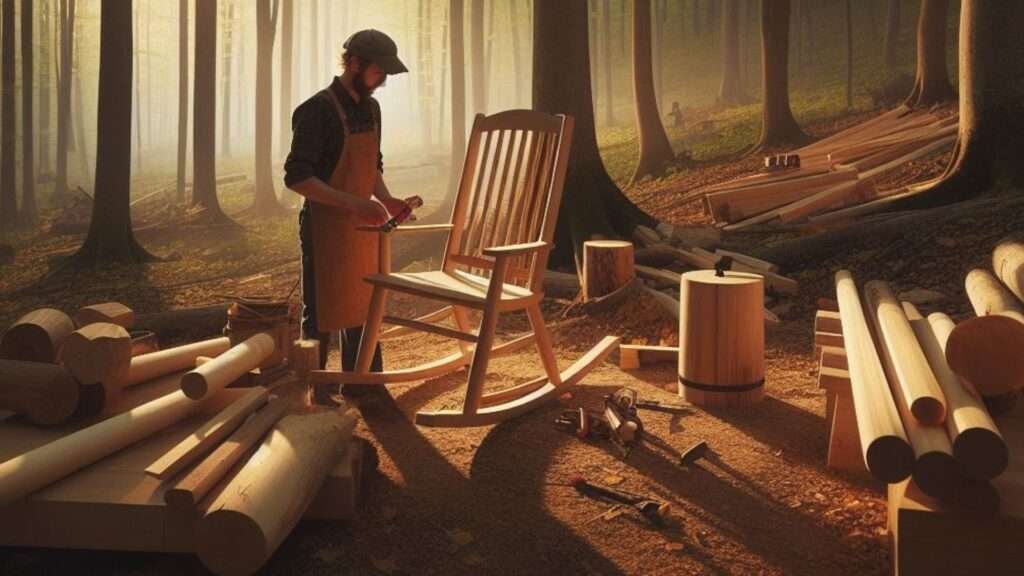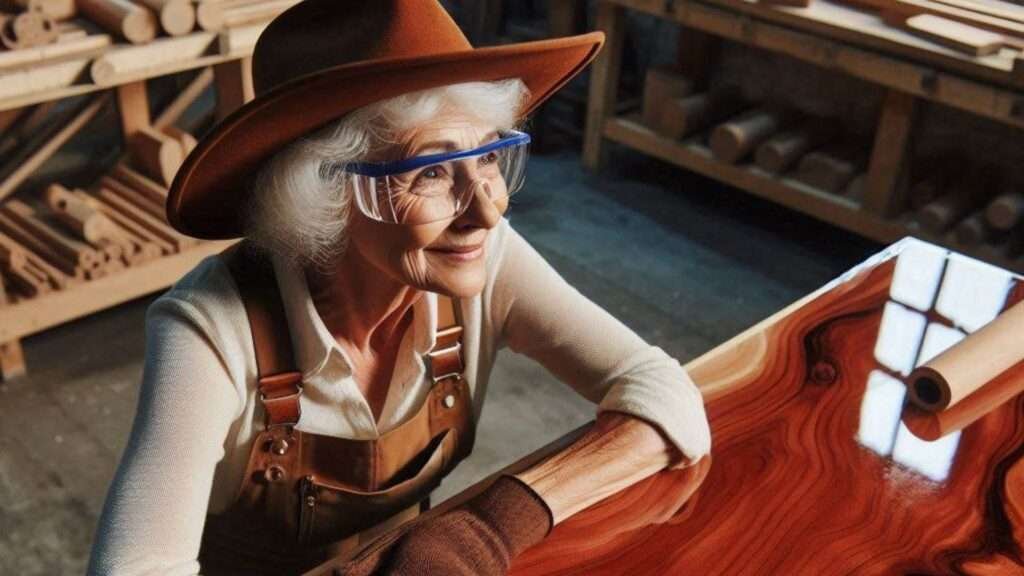Maple Wood Is Embraced By Many Woodworkers.
Maple wood has long held a cherished place in the heart of
woodworking enthusiasts, celebrated for both its versatility and inherent
beauty.
Originating from the robust and diverse family of maple trees,
this species of wood captures the essence of craftsmanship through its fine
texture and appealing grain patterns.
The allure of maple extends beyond its aesthetic appeal,
offering a remarkable balance of strength and workability that makes it a
favorite amongst artisans and DIY enthusiasts alike.
The historical significance of maple in woodworking is a
testament to its enduring popularity. Ancient civilizations, particularly in
North America, utilized maple wood for creating tools, furniture, and even
musical instruments, attributing to its durability and resonant qualities.
The dense grain structure of maple not only made it an ideal
material for functional items but also allowed for intricate carvings and
detailed work, paving the way for its sustained use over centuries.
In modern times, the appreciation for maple wood has only
grown. Its versatility is showcased in a myriad of applications, from flooring
and cabinetry to decorative veneers and custom furniture pieces.
Woodworkers prize maple for its ability to take stains and
finishes exceptionally well, enabling a wide range of visual effects that
enhance the natural beauty of the wood.
Moreover, the inherent strength and stability of maple ensure
that creations made from this wood stand the test of time, marrying form and
function seamlessly.
As we delve deeper into the world of maple woodworking, it
becomes clear why this wood continues to captivate both seasoned craftsmen and
newcomers to the craft.
The combination of historical reverence and contemporary
application underscores the timeless appeal of maple, making it not just a
material of choice but a cornerstone in the art of woodworking.
Understanding Maple Trees.
Maple trees are a diverse group of trees that belong to the
genus Acer. They are widely appreciated not only for their aesthetic appeal but
also for their practical applications in woodworking.
There are over 100 species of maple trees, each with unique
characteristics that make them valuable in different contexts.
The most common species used in woodworking include Sugar
Maple (Acer saccharum), Red Maple (Acer rubrum), and Silver Maple (Acer
saccharinum).
Identifying maple trees in the wild involves examining several
key features: the leaves, bark, and overall growth pattern.
Maple leaves are typically arranged oppositely on the branches
and are characterized by their lobed shape with pointed tips.
Each species has slightly different leaf shapes, making them a
useful tool for identification. For instance, the Sugar Maple has five distinct
lobes with smooth edges, while the Red Maple’s leaves have serrated edges and
three to five lobes.
The bark of maple trees also varies significantly between
species. Sugar Maple bark is grayish-brown with deep furrows, whereas Red Maple
bark is smoother and tends to be light gray.
Silver Maple has flaky bark that peels away in thin strips,
revealing an inner bark layer that is often a lighter color.
Observing these differences can help in identifying and
selecting the appropriate type of maple for specific woodworking projects.
Maple trees thrive in a range of habitats, from rich,
well-drained soils to areas near water bodies.
Sugar Maples prefer the cool, moist climates of the
northeastern United States and Canada, while Red Maples are more adaptable,
found in various regions across North America.
Silver Maples grow rapidly and are often located in
floodplains and wet areas. Understanding the natural habitats and growth
patterns of these trees can provide insight into their wood quality and
availability.
With woodworking, the choice of maple species can
significantly influence the outcome of the project.
Each type offers distinct advantages; Sugar Maple is prized
for its hardness and fine grain, making it ideal for furniture and flooring.
Red Maple, with its softer wood, is often used in decorative
veneers and turning projects. Silver Maple, being more lightweight, is suitable
for applications where ease of handling is a priority.
The Unparalleled Beauty of Maple Wood.
Maple wood stands out in the realm of woodworking for its
remarkable beauty and distinctive characteristics.
One of the first aspects that captivate woodworkers and
enthusiasts alike is its color. Maple wood is generally light in hue, ranging
from creamy white to light reddish-brown, which allows for versatile
applications in furniture and cabinetry.
This light color not only provides an elegant and clean appearance
but also serves as an excellent canvas for stains and finishes, enabling
woodworkers to achieve a variety of aesthetic effects.
The grain patterns of maple wood further enhance its visual
appeal. Typically, maple exhibits a fine, even texture with straight grain;
however, it can also present more unique patterns such as birdseye, curly, or
quilted figures.
These distinctive grain variations are highly sought after and
often used for decorative purposes, adding a touch of sophistication and uniqueness
to any piece. The natural beauty of these patterns ensures that each project
made from maple wood is truly one-of-a-kind.
Beyond its visual attributes, maple wood is renowned for its
hardness and durability. The hardwood nature of maple makes it exceptionally
resistant to wear and tear, which is why it is frequently used in high-traffic
applications like flooring, butcher blocks, and cutting boards.
This hardness not only contributes to the longevity of the
products but also provides a sturdy and reliable material for crafting
intricate designs and structures.
The combination of color, grain patterns, and hardness makes
maple wood a top choice among woodworkers.
Its ability to blend aesthetic beauty with practical
durability ensures that maple wood remains a popular option for a wide range of
woodworking projects.
Whether aiming for a modern minimalistic look or a more
traditional, ornate style, the unparalleled beauty of maple wood can be
harnessed to unlock the full potential of any creation.
Maple Wood Properties and Uses.
Maple wood is renowned in the woodworking community for its
impressive array of properties and versatility.
One of the key attributes of maple wood is its density. With a
Janka hardness rating that ranges from 700 to 1,450 pounds-force, maple is a
sturdy and resilient hardwood.
This makes it an excellent choice for projects that require a
durable material capable of withstanding significant wear and tear.
The workability of maple wood is another notable feature.
Despite its density, maple is relatively easy to work with using both hand
tools and machinery.
It machines well, sands smoothly, and finishes beautifully,
making it a favorite among woodworkers for a variety of intricate tasks.
Additionally, maple’s fine and uniform texture, combined with
its natural luster, enhances its aesthetic appeal.
When it comes to durability, maple wood stands out. Its
resistance to abrasion and impact makes it a popular choice for high-traffic
areas and items that need to endure frequent use.
This toughness extends to its ability to resist dents and
scratches, which is particularly advantageous for flooring and cabinetry.
Maple wood’s practical properties are matched by its wide
range of uses in woodworking.
It is commonly utilized in the creation of furniture, where
its strength and beautiful grain patterns add both structural integrity and
visual charm.
In cabinetry, maple’s smooth finish and ability to be stained
in various shades make it an adaptable material that suits diverse design
preferences.
Flooring is another prominent application of maple wood. Its
hardness and resistance to wear make it ideal for both residential and
commercial spaces.
Woodturners and carvers also favor maple due to its ease of
shaping and detailed finishing potential.
Whether crafting intricate designs or robust furniture pieces,
maple’s versatility and reliability make it an invaluable resource in the
woodworking industry.
Mastering the Art of Working with Maple Wood.
Maple wood, renowned for its durability and fine grain, is a
favored choice among woodworkers. However, to fully unlock its potential, one
must master specific techniques and use appropriate tools.
The process of working with maple wood involves meticulous
cutting, finishing, joinery, and drying practices to ensure excellence in every
project.
When cutting maple wood, it’s crucial to use sharp,
high-quality blades due to its density and hardness.
Dull blades can cause chipping and tear-out, compromising the
wood’s smooth finish. For best results, opt for carbide-tipped saw blades or
high-speed steel (HSS) cutters. Additionally, employing a slow and steady feed
rate can minimize the risk of splintering.
Finishing maple wood requires a methodical approach to
highlight its natural beauty. Begin by sanding the surface with progressively
finer grits, starting from 100 and moving up to 220 grit.
This ensures a smooth, blemish-free surface. Applying a
pre-stain wood conditioner is advisable to prevent blotching, especially with
soft maple.
Follow with a stain of your choice or a clear finish to
enhance the wood’s innate luster. Polyurethane or varnish can provide a
durable, protective layer.
Joinery with maple wood demands precision and the right tools.
Given its hardness, using high-quality chisels and saws is essential.
Dovetail and mortise-and-tenon joints are particularly
effective for maple woodworking projects, providing strong, durable
connections.
Gluing maple can sometimes be challenging due to its density;
therefore, using clamps to ensure a tight bond and allowing ample drying time
is recommended.
The drying process is another critical aspect of working with
maple wood. Maple is prone to warping and cracking if not dried correctly.
Ideally, it should be air-dried slowly to reduce internal
stresses, followed by kiln drying to achieve the desired moisture content. This
careful approach helps maintain the wood’s structural integrity and appearance.
To achieve optimal results when working with maple wood, employing
the right tools is essential. High-quality saws, sanders, chisels, and clamps
can significantly enhance the precision and finish of your projects.
Investing in these tools not only improves your craftsmanship
but also ensures the longevity and beauty of your maple wood creations.
Maple Woodworking Projects.
Maple wood is celebrated for its versatility and durability,
making it a popular choice for a wide range of woodworking projects.
Its fine, uniform texture and straight grain contribute to its
adaptability in both functional and decorative applications.
This section explores the myriad possibilities of maple wood
in various woodworking projects, demonstrating its potential to create stunning
and long-lasting pieces.
One of the most common uses of maple is in furniture making.
Its strength and resilience ensure that furniture pieces, such as tables,
chairs, and bed frames, can withstand daily wear and tear.
Additionally, maple’s attractive appearance, which can be
enhanced through staining or finishing, makes it an excellent choice for
crafting visually appealing furniture.
Whether it’s a sleek modern coffee table or a classic dining
set, maple wood’s versatility shines through in furniture projects.
Maple is also highly favored in cabinetry. Its ability to
resist abrasion and its fine grain make it ideal for kitchen and bathroom
cabinets.
The wood’s light, natural color can brighten up any space,
while its ability to accept stains allows for a wide range of aesthetic
possibilities.
Maple cabinets offer not only beauty but also durability,
ensuring that they remain functional and attractive for years.
Flooring is another domain where maple wood excels. Maple
hardwood floors are renowned for their hardness and ability to withstand heavy
foot traffic.
The wood’s natural luster and the variety of finishes
available make maple flooring a versatile choice for both traditional and
contemporary interiors.
Its durability and timeless beauty make it a popular option
for homeowners looking to invest in quality flooring.
Beyond furniture, cabinetry, and flooring, maple wood is also
used in creating decorative items. Its fine texture and workability make it
suitable for intricate carvings and turnings.
From ornate picture frames to delicate jewelry boxes, maple’s
adaptability allows artisans to craft detailed and refined decorative pieces.
The wood’s inherent beauty enhances these items, making them
both functional and aesthetically pleasing.
In conclusion, maple wood’s versatility in woodworking
projects is unmatched. Its strength, durability, and aesthetic appeal make it a
preferred choice for a wide range of applications, from furniture and cabinetry
to flooring and decorative items.
By exploring the potential of maple, woodworkers can create
stunning, lasting pieces that showcase the wood’s unique properties.
Embracing the Maple Woodworking Tradition.
Maple wood has long held a prestigious place in woodworking
traditions across the globe. Its fine, consistent grain and durability make it
a favored material for artisans and furniture makers alike.
Historically, maple has been a cornerstone of craftsmanship,
with its use dating back centuries. In
North America, Native American tribes utilized maple for everything from tools
to musical instruments, capitalizing on its resilience and workability.
In the 18th and 19th centuries, renowned furniture makers such
as Duncan Phyfe and Thomas Chippendale celebrated maple for its beauty and
strength.
Phyfe, an American cabinetmaker, was known for his
neoclassical style, often incorporating maple into his elegant and intricate
designs.
Similarly, Chippendale, a British cabinetmaker, frequently
utilized maple in his iconic pieces, which combined both Gothic and Rococo
influences.
Their masterpieces not only highlighted the aesthetic appeal
of maple but also showcased its versatility and structural integrity.
Maple woodworking traditions extend beyond North America and
Europe. In Japan, for example, maple, or “momiji,” has been a beloved
material in traditional carpentry and woodcraft for centuries.
Japanese woodworkers seem to appreciate maple for its fine
texture and ability to hold intricate details, making it ideal for creating the
delicate joinery and finishes seen in traditional Japanese furniture and
architecture.
The legacy of maple woodworking continues to thrive in modern
times. Contemporary artisans and woodworkers still prize maple for its enduring
qualities and adaptability.
Whether crafting heirloom furniture, musical instruments, or
intricate carvings, the tradition of using maple wood remains a testament to
its timeless appeal and unmatched capabilities.
The rich history and craftsmanship associated with maple wood
not only underscore its significance in the woodworking world but also inspire
new generations to unlock its full potential.
Unlocking the Full Potential of Maple Wood.
To fully harness the potential of maple wood in your
woodworking projects, it is imperative to have an in-depth understanding of its
unique properties.
Maple’s hardness and durability make it an ideal choice for a
variety of applications, from furniture to flooring.
Its fine, even grain allows for smooth finishes and intricate
detailing, offering both functionality and aesthetic appeal.
Recognizing these characteristics can significantly influence
your woodworking techniques and outcomes.
Mastering the appropriate woodworking techniques is essential
when working with maple. Due to its density, it is crucial to use sharp tools
to achieve clean cuts and avoid tear-out. Additionally, pre-drilling holes can
prevent splitting when inserting screws.
Sanding maple wood requires a graduated approach, starting
with coarser grits and progressing to finer ones to achieve a flawless finish.
Employing these techniques will not only enhance the quality
of your work but also prolong the lifespan of your tools.
Appreciating the beauty and versatility of maple wood can
elevate your projects to new heights.
Its natural light color and subtle grain patterns lend
themselves well to a variety of stains and finishes, allowing for a wide range
of design possibilities.
Maple’s adaptability makes it suitable for both traditional
and contemporary styles, providing endless opportunities for creative
expression.
By experimenting with different finishes and techniques, you
can unlock the full spectrum of maple’s aesthetic potential.
In conclusion.
Understanding maple’s properties, mastering the necessary
techniques, and appreciating its inherent beauty are key to unlocking its full
potential in woodworking.
By integrating these elements into your approach, you can
create stunning, durable pieces that stand the test of time.
Whether you are a seasoned woodworker or a novice, maple wood
offers a rewarding canvas for your craftsmanship.








